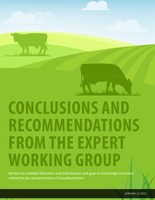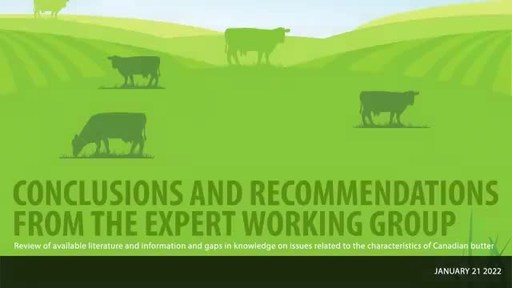Canadian academics and experts of various spheres of expertise conclude multiple factors play a role in the texture of butter
MONTREAL, Jan. 21, 2022 /CNW Telbec/ - The Expert Working Group on feed supplementation released its report today. The group had been convened to investigate questions about the texture of butter and if there was a link with animal feed supplements containing palm by-products.
Dairy Farmers of Canada approached Dr. Daniel Lefebvre, Chief Operations Officer - Director, Centre of Expertise at Lactanet to lead a group of experts to further explore this issue.
The 13-member Expert Working Group met seven times from March to December 2021 and sought presentations and reports from several outside experts.
In addition to a comprehensive review of the scientific literature, the Group also commissioned two data collection efforts:
- Assessment, compilation and statistical analysis of the fatty acid composition of raw milk from across Canada.
- Collection of samples of retail butter from across Canada and subsequent analysis of the fatty acid profile and physical properties.
Here are some highlights of the report:
- Milk fat is one of the most complex natural fat, containing more than 400 different fatty acids.
- Palmitic acid (C16:0) is a saturated fat and the predominant fatty acid in milk, regardless of what cows eat. It is also the most common fatty acid in animal fats and many plant oils. Cows produce palmitic acid naturally, along with hundreds of other fatty acids in their milk.
- Ingredients in animal feed also contain fatty acids, including palmitic acid. Feeding cows palm-derived feed supplements contributes to cows' palmitic acid intake but is not the main factor contributing to palmitic acid in milk.
- Most of the palmitic acid present in milk is derived from the cow eating traditional feed ingredients, mainly hay, silage, grass and cereal grains, and making it naturally in her udder.
- Additionally, the fatty acid composition of milk is influenced by a variety of other factors including season, stage of lactation, diet (influenced by geographic region) and a range of other variables.
- With respect to processing, the literature review indicates that cream handling, temperature of storage and churning are key factors that may affect the rheological properties of final products including the firmness and texture of butter.
"After a careful review of the existing scientific literature and undertaking new testing and consultations with various industry and academic experts, we cannot conclude that any perceived increase in the hardness of butter be solely attributed to the use of palm-derived feed supplements," said Daniel Lefebvre, Chair of the Expert Working Group. "There is a variety of factors that influence the fatty acid profile of milk which is only one of the factors that can affect butter consistency. We have also concluded there are gaps in the body of knowledge that should be addressed, and we offered a series of recommendations to better understand issues related to the properties of butter while also ensuring that industry is better equipped to meet consumer expectations."
BACKGROUNDER – Establishing an Expert Working Group, Scope of Work and Biographies
Establishing an Expert Working Group
The Expert Working Group includes prominent academics and experts from across Canada, with a diverse range of expertise. All are recognized as leaders in their fields, with specializations in areas such as dairy nutrition, animal health, sustainability, food science, and human nutrition. The group also includes representation from the Consumers' Association of Canada and participation from dairy processors and farmer group experts. The group met seven times from March to November and solicited presentations and reports from several outside experts.
Scope of work
The Expert Working Group set the scope of its work and established the following key objectives:
- Confirm whether there are or have been changes in the characteristics of butter;
- Review the literature to assess current science as it relates to:
- Feeding of palm-derived lipids to cows
- Milk composition
- Milk handling and processing techniques and
- Health and safety of supplements.
- Identify any gaps in data or research;
- Review of the level of sustainability of palm-derived feed supplements;
- Assess the role and nutritional value of palm-derived feed supplements for dairy cows.
Biographies
The biographies are available in Appendix 3 of the report.
SOURCE Expert Working Group on feed supplementation

Adam Taylor, 613-809-9139


Share this article